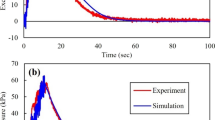Abstract
The design of circular type cellular cofferdams is formulated as a nonlinear optimization model that takes explicit account of relevant economic and technologic aspects. The objective is minimization of total expected cost. The constraints arise from stability critera to protect against failures due to slipping of the sheet piles on the river side and interlock stresses at the joint. A solution achieved with geometric programming techniques, yields optimal cell sizes and design heights. The geometric programming approach provides important design insights by yielding the proportions of the total cost to be assigned to the cost components, fill material, sheet piling and flooding in an optimal design.
Similar content being viewed by others
References
P.A. Beck and J.G. Ecker, “Some computational experience with a modified convex simplex algorithm for geometric programming,” Report ADTC-12-20, Rensselaer Polytechnic Institute, Troy, N.Y. 12181 (1972).
R.J. Duffin, E.L. Peterson and C. Zener,Geometric programming (Wiley, New York, 1967).
F. Neghabat, “Optimization in cofferdam design,” Ph.D. dissertation, University of Delaware, June 1970.
F. Neghabat and R.M. Stark, “Optimum cofferdam height,” Preprint ASCE National Meeting, July 1970.
R.M. Stark and R.L. Nicholls,Mathematical foundations for design, civil engineering systems (McGraw-Hill, New York, 1972).
W.C. Teng,Foundations design (Prentice-Hall, Englewood Cliffs, N.J., 1962).
Tennessee Valley Authority,Steel sheet piling cellular cofferdams on rock, Technical Monograph No. 75, Vol. 1 (1966).
K. Terzaghi, “Stability and stiffness of cellular cofferdam,”Transactions of ASCE 110 (1945).
L.W. White and E.A. Prentis,Cofferdams, second edition (Columbia University Press, New York, 1950).
D.J. Wilde and C.S. Beightler,Foundations of optimization (Prentice-Hall, Englewood Cliffs, N.J., 1967).
Author information
Authors and Affiliations
Additional information
Currently on leave at the Massachusetts Institute of Technology, Cambridge, Mass., USA.
Rights and permissions
About this article
Cite this article
Neghabat, F., Stark, R.M. A cofferdam design optimization. Mathematical Programming 3, 263–275 (1972). https://doi.org/10.1007/BF01585000
Received:
Revised:
Issue Date:
DOI: https://doi.org/10.1007/BF01585000




